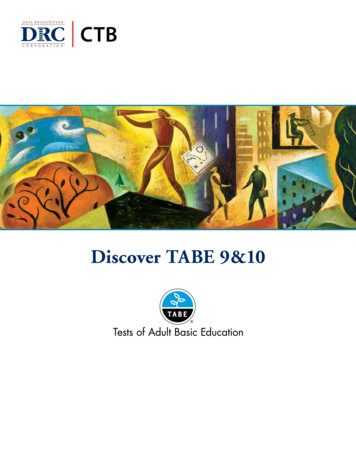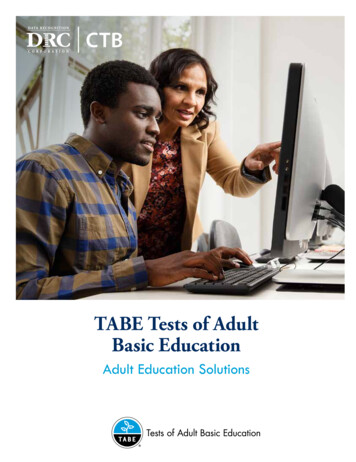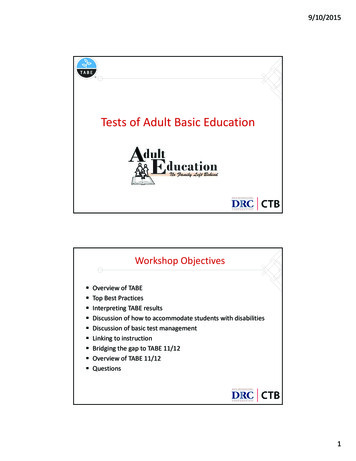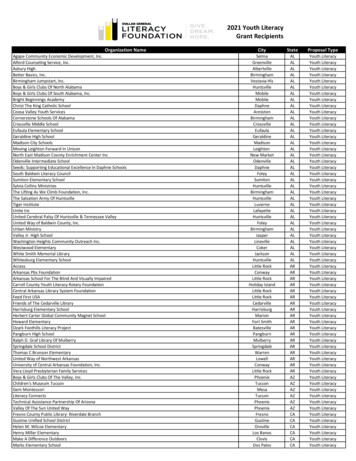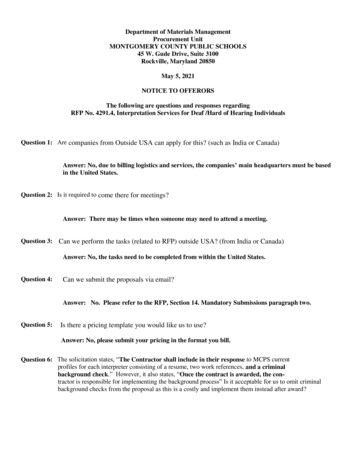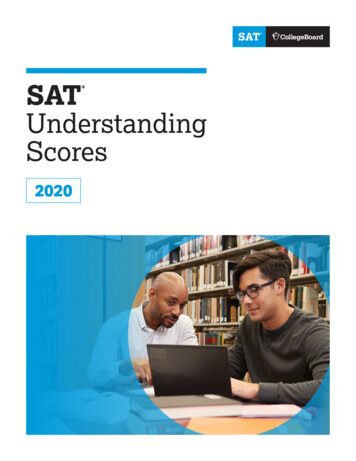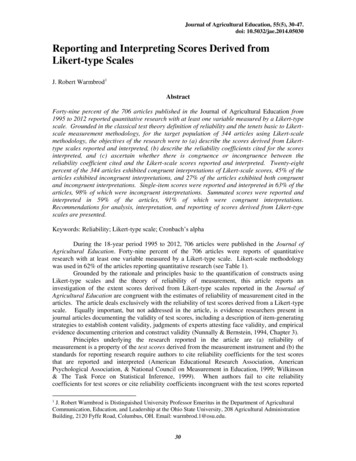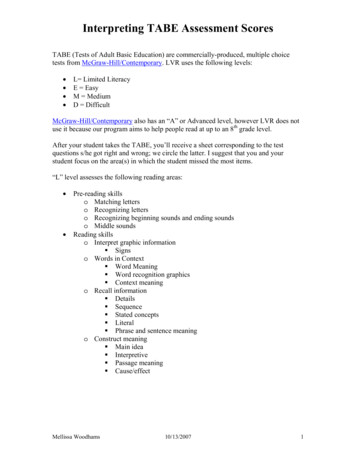
Transcription
Interpreting TABE Assessment ScoresTABE (Tests of Adult Basic Education) are commercially-produced, multiple choicetests from McGraw-Hill/Contemporary. LVR uses the following levels: L Limited LiteracyE EasyM MediumD DifficultMcGraw-Hill/Contemporary also has an “A” or Advanced level, however LVR does notuse it because our program aims to help people read at up to an 8th grade level.After your student takes the TABE, you’ll receive a sheet corresponding to the testquestions s/he got right and wrong; we circle the latter. I suggest that you and yourstudent focus on the area(s) in which the student missed the most items.“L” level assesses the following reading areas: Pre-reading skillso Matching letterso Recognizing letterso Recognizing beginning sounds and ending soundso Middle soundsReading skillso Interpret graphic information Signso Words in Context Word Meaning Word recognition graphics Context meaningo Recall information Details Sequence Stated concepts Literal Phrase and sentence meaningo Construct meaning Main idea Interpretive Passage meaning Cause/effectMellissa Woodhams10/13/20071
Interpreting TABE Assessment ScoresLevels E, M, and D assess the following reading areas: Interpret graphic informationo Signso Mapso Indexo Reference sourceso Graphso Formso Consumer materialsWords in contexto Same meaningo Opposite meaningo Appropriate wordRecall informationo Detailso Sequenceo Stated conceptsConstruct meaningo Character aspectso Main ideao Summary/paraphraseo Cause/effecto Compare/contrasto Conclusiono Supporting evidenceEvaluate/extend meaningo Fact/opiniono Predict outcomeso Apply passage elementso Generalizationso Effect/intentiono Author purposeo Style techniqueso Genreo Generalizationo Effect/intentiono Author purposeo Style techniquesYou’ll see “forms 9 and 10” on the results; this is McGraw-Hill/Contemporarynomenclature for their tests.Mellissa Woodhams10/13/20072
Interpreting TABE Assessment ScoresTABE, especially levels E and M, does not evaluate a person's decoding or word analysisskills. It is important for tutors to evaluate or assess these skills using some of theinformal assessments we have in the office.Remember, TABE levels E and M are timed tests. If a student does not finish all 50questions in the allotted time of 50 minutes, you should determine if there are fluencyissues or test taking strategy issues. Test taking strategies are important to our learnerswho are trying to get their GED or enter a training program that has an entrancerequirement.We assess students each year. The office contacts students at the appropriate time.Reassessment helps gauge progress, drive instruction, and helps LVR demonstrate theeffectiveness of our program. Please notify the office immediately if the learner isdiscontinuing for any reason.I suggest the following material in our library: Contemporary’s Reading Basics: IntroductoryContemporary’s Reading Basics: Intermediate 1The Steck-Vaughn Comprehension Skills serieso Conclusion 1o Contexto Context 1o Context 2o Factso Facts 1o Facts 2o Main Idea 1o Main Idea 2o Teacher’s ManualTABE: Content area skill exercisesThis three-ring binder contains McGraw-Hill/Contemporary exercises for levels Ethrough AMellissa Woodhams10/13/20073
TABE Results Sheet for Level L, Limited LiteracyForms 9 and 10Objective and subskillForm 9Form 10Matching Letters1,2,3,4,5,61,2,3,4,5,6Recognizing Letters7,8,9,107,8,9,10Recognizing beginning soundsand ending sounds11,12,13,1411,12,13,14Middle sounds15,16,17,1815,16,17,18Interpret graphic informationSigns1,2,3,41,2,3,4Words in ContextWord 1613,14,15,163028Pre-Reading skillsReading skillsWord recognition graphicsContext meaningRecall informationDetailsSequence29,30Stated 32Interpretive27,2926Passage meaning21,22,23,24,2521,22,23,24Phrase and sentence meaningConstruct meaningMain IdeaCause/effect3111/6/2007
TABE Content Area Skill ExercisesTable of Contents(in LVR Library)Level EActivity 1 page 2.5Objective: Construct meaningSubskills: Compare/contrast, Character aspectsand Cause/effectActivity 2 page 2.11Objective: Interpret Graphic InformationSubskills: Graphs and Consumer materialsActivity 3 page 2.19Objective: Recall InformationSubskills: Details, Stated Concepts and SequenceActivity 4 page 2.25Objective: Construct meaningSubskills: Main idea, and Character aspectsLevel MActivity 5 page 2.33Objective: Interpret graphic informationSubskills: Maps and GraphsActivity 6 page 2.39Objective: Recall informationSubskills: Details and SequenceActivity 7 page 2.45Objective: Construct meaningSubskills: Cause/effect and ConclusionLevel DActivity 8 page 2.51Objective: Interpret graphic informationSubskills: Index and Consumer materialsActivity 9 page 2.57Objective: Recall informationSubskills: Details and SequenceActivity 10 .page 2.65Objective: Construct meaningSubskills: Main idea, Supporting evidence and Summary11/6/2007
TABE Content Area Skill ExercisesTable of Contents(in LVR Library)Level D cont.Activity 11 .page 2.71Objective: Evaluate/extend meaningSubskills: Genre and Style techniquesLevel AActivity 12 .page 2.81Objective: Recall informationSubskills: Details and Stated conceptsActivity 13 .page 2.87Objective: Construct meaningSubskills: Character aspects, Compare/contrastand conclusionActivity 14 page 2.95Objective: Construct meaningSubskills: Summary/paraphrase, main idea,Supporting evidence and ConclusionActivity 15 .page 2.103Objective: Evaluate/extend meaningSubskills: Author purpose, Predict outcome andStyle techniquesAnswers to student worksheets .page 2.17711/6/2007
TABE Results Sheet for Level L, Limited Literacy Forms 9 and 10 11/6/2007 Objective and subskill Form 9 Form 10 Pre-Reading skills Matching Letters 1,2,3,4,5,6
